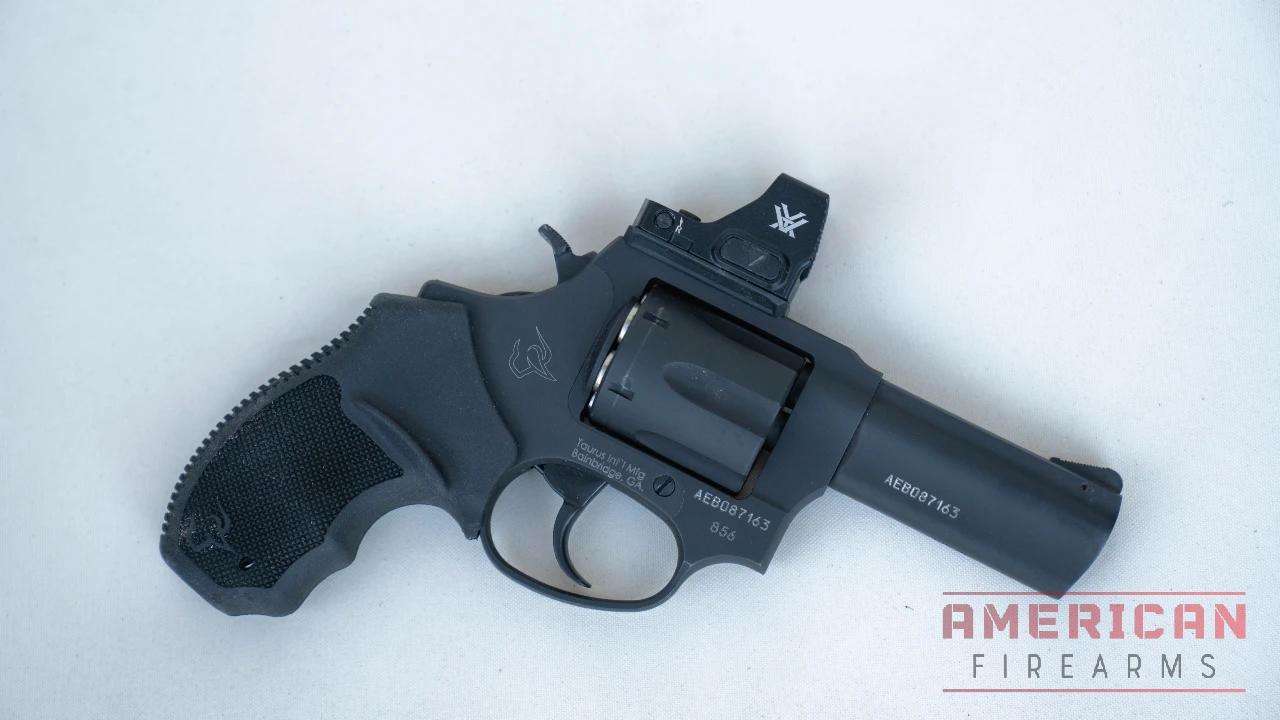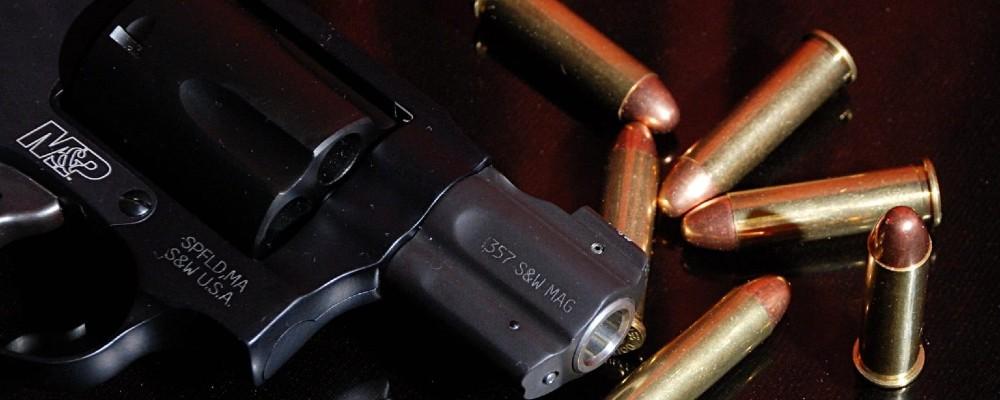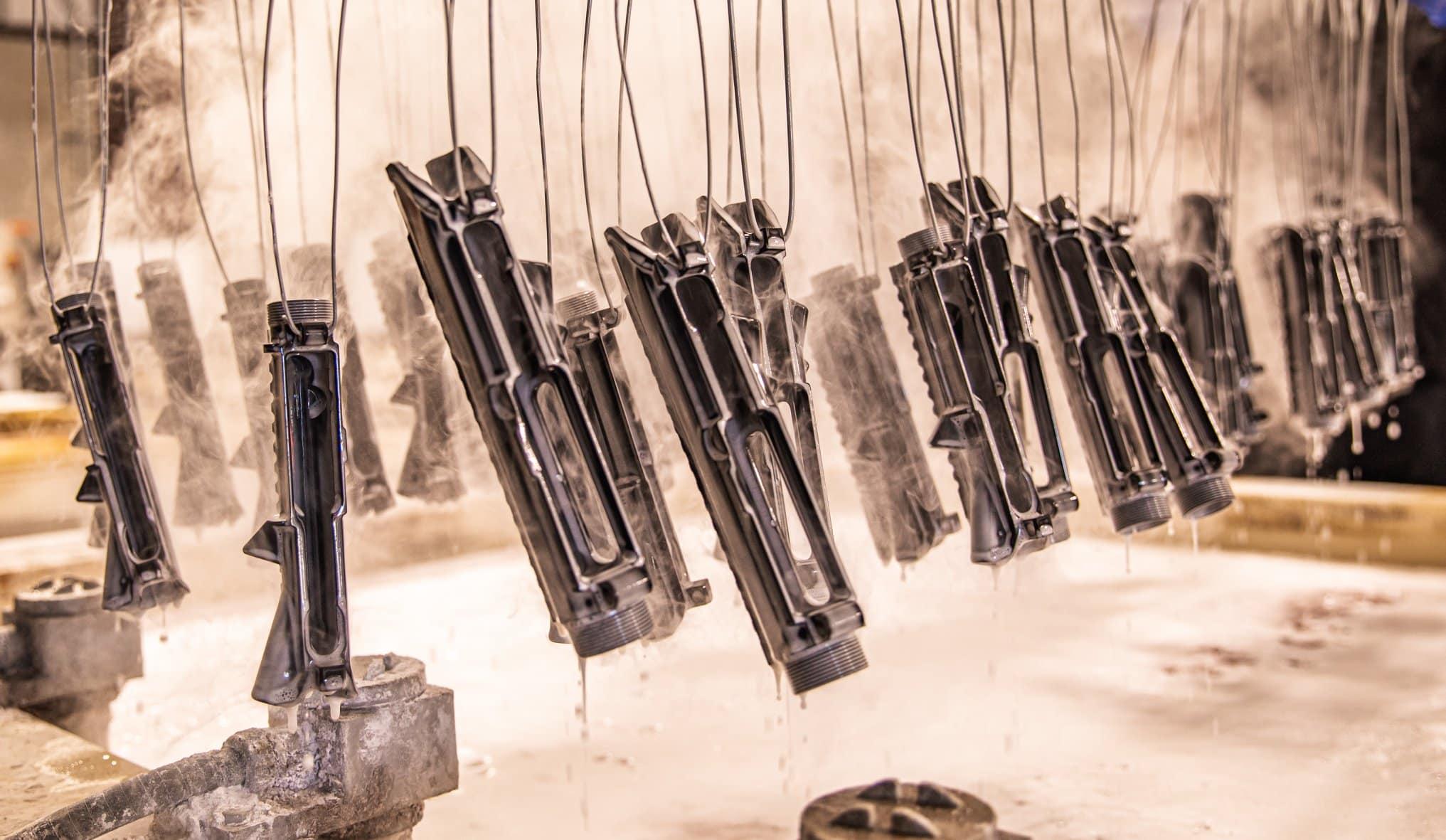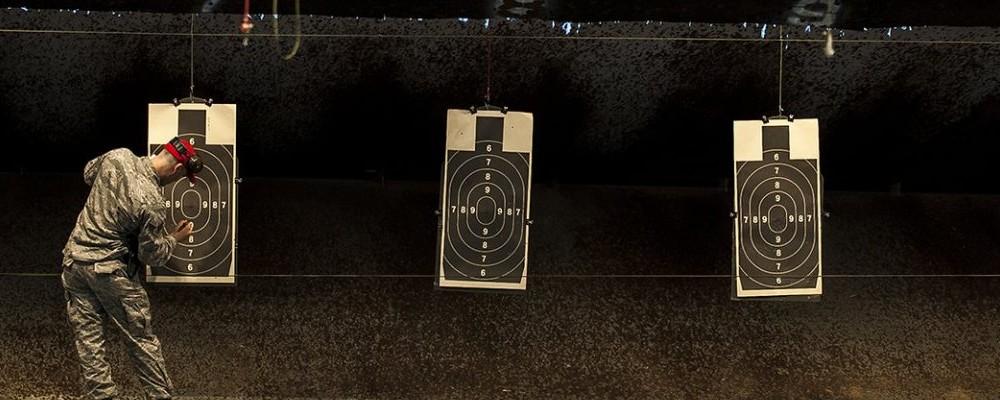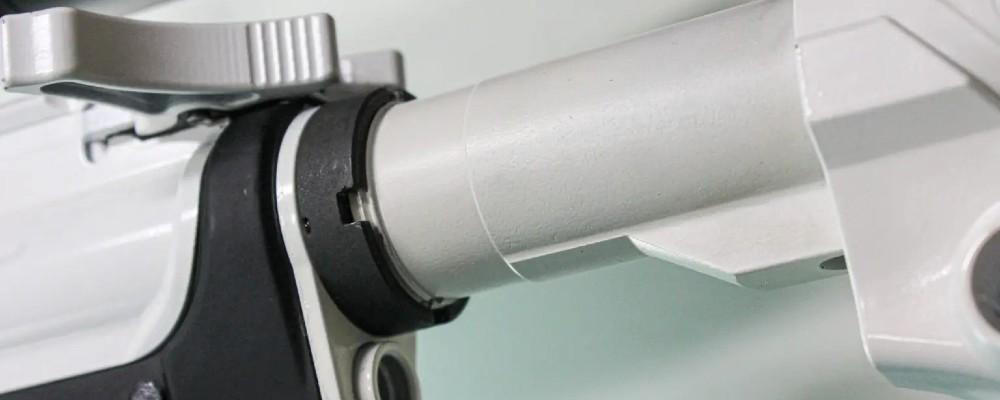Ruger Wrangler Review: Is This $180 .22 Revolver Worth It in 2026?
Our hands-on Ruger Wrangler review covers 500+ rounds tested, all 4 variants, 10+ ammunition types, and detailed comparisons vs. Heritage Rough Rider and Single Six. Real accuracy data, pros/cons, and buying advice.
Written By
Megan Kriss
Expert Contributor
Edited By
Michael Crites
Licensed Concealed Carry Holder
Share:
Products are selected by our editors. We may earn a commission on purchases from a link. How we select gear.
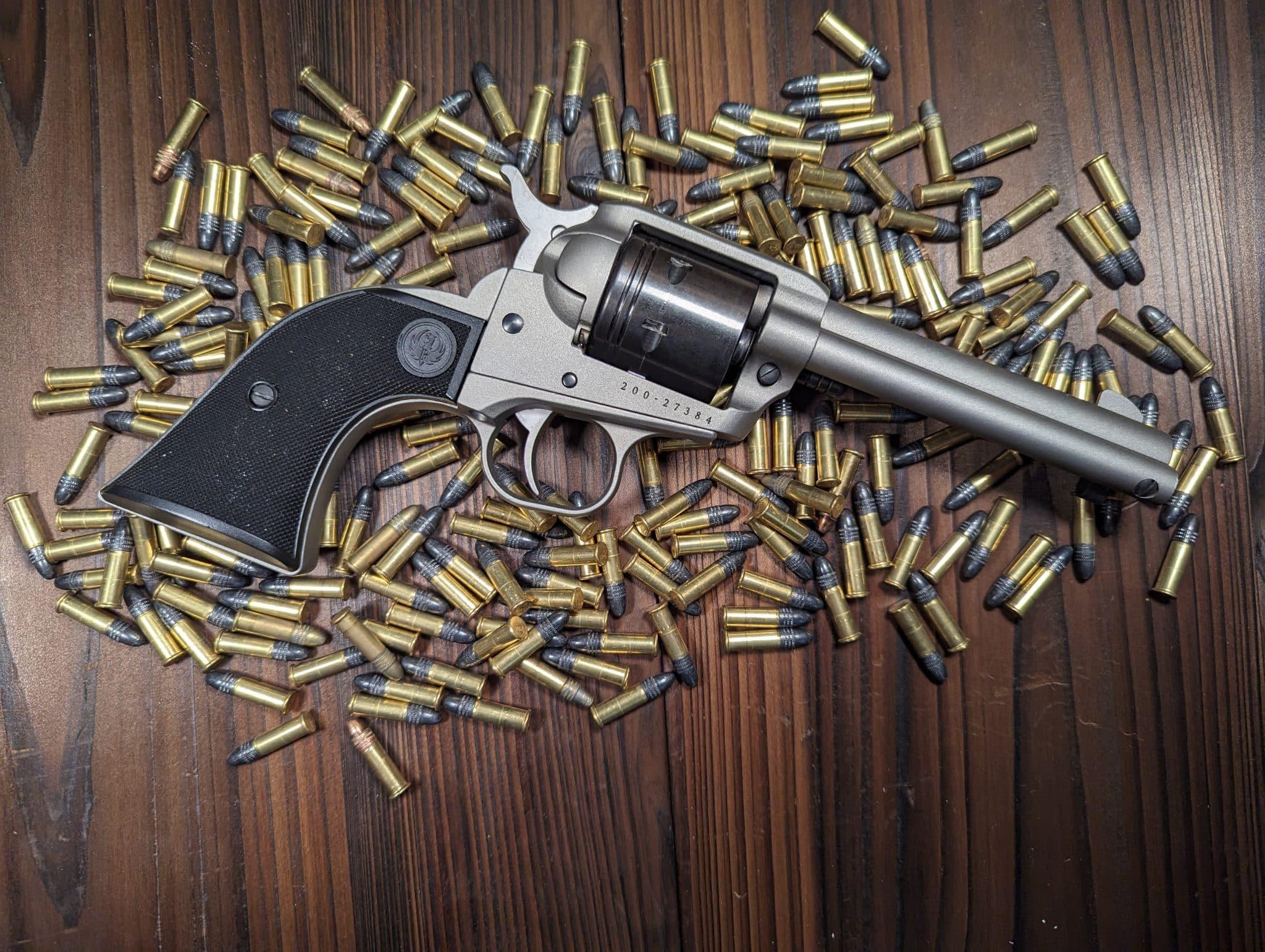
Updated
Dec 2025
The Ruger Wrangler has quickly become one of Ruger’s most popular offerings and is a fan favorite among rimfire shooters on a budget. These kinds of inexpensive plinkers are fun to shoot, but with many brands that focus on fun can mean sub-standard quality and, uh, generous tolerances.
That said, Ruger has a reputation for putting out quality, reliable products, so were curious — is the Wrangler really such a great value or is it a case of being blinded by a cheap price tag?
We wanted to find out. Ruger has a long history of well-made .22 revolvers with the Single Six, so we had high hopes for the Wrangler, which is marketed as a stripped-down, budget-friendly version of the iconic Single Six.
Let’s see how Ruger did on this one.
In This Article
A Newly Classic Piece of Americana
Ruger only introduced the Wrangler a few years ago, back in 2019, but its nostalgic design harkens back to revolvers much older than that.
The design is very similar to that of Ruger’s Single Six (and, in fact, the Single Six and Wrangler share a lot of internal components), which has been manufactured since the 1950s.
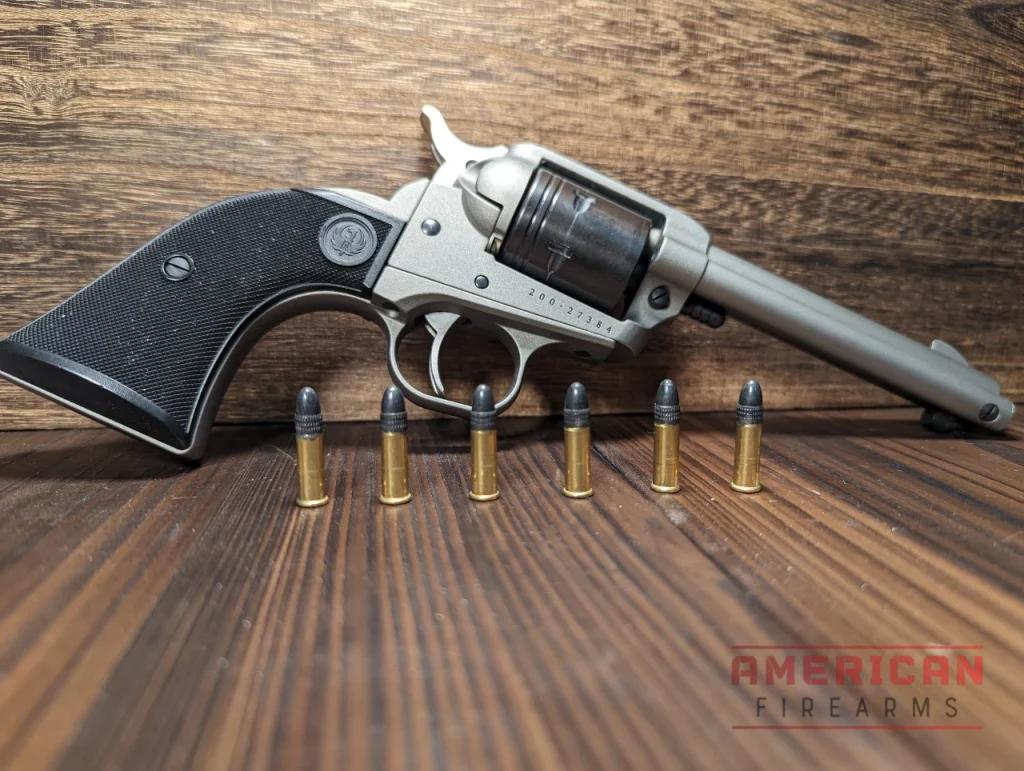
Both the Single Six and the Wrangler, however, owe their designs to an even older revolver, the Colt Single Action Army (or SAA). This venerable revolver was originally designed more than a century ago, way back in 1872, so the Ruger Wrangler’s roots are actually much deeper than the 2019 release date would indicate.
Of course, you’ll pay a lot less for the Wrangler than a Colt Single Action Army or even a Single Six. For one, it’s a smaller gun. It’s also got a simpler design that cuts out some of the extra bells and whistles that you get from the Single Six, like interchangeable cylinders and an adjustable rear sight.
But we’ll go more in-depth about the Single Six and how it compares to the Wrangler shortly.
Finally, in addition to the more SAA-based design, there’s another version of the Wrangler with Birdshead grips and a shorter barrel that’s clearly based on the Ruger Vaquero. I have the SAA-style version, so that’s the one I’m primarily focusing this review on. However, I will make a few notes about the Birdshead version here and there as well.
Anyway, now that we know the Wrangler’s roots, let’s go into some more detail about this rimfire revolver.
How We Tested The Wrangler
Feel & Accuracy
We fire multiple groups at 7, 10, and 15 yards to evaluate practical accuracy with various ammunition types, measure groupings to assess consistency, and use a trigger scale to measure pull weight and evaluate reset characteristics.
Reliability
We fire a minimum of 500+ rounds of varied ammunition including budget bulk packs, premium loads, and subsonic rounds to ensure the revolver functions without failures, and we track any light strikes, timing issues, or extraction problems across the entire testing period.
Durability
We evaluate wear on the Cerakote finish, cylinder lockup, and timing throughout testing. We also assess the loading gate break-in period, check for any metal wear on the cylinder face and barrel forcing cone, and examine internal components for signs of stress or premature wear.
Ease of Use
We evaluate loading and unloading procedures, cylinder removal for cleaning, ejector rod effectiveness, and overall handling characteristics. We also have multiple shooters with different hand sizes test the ergonomics and provide feedback on comfort and control.
More on our testing process

$205.99

44
EXCEPTIONAL
2026 Awards & Rankings
Performance Scores
Breaking Down The Wrangler Variants
When Ruger introduced the Wrangler in 2019, they started with a single configuration: the 4.62″ barrel model with traditional plow-handle grips.
Since then, they’ve expanded the lineup to include shorter and longer barrel options, a compact Birdshead variant, and most recently, the game-changing Super Wrangler with convertible cylinders. Understanding the differences between these variants will help you choose the right Wrangler for your needs.
Standard Model (4.62″ Barrel)

The 4.62″ barrel model is the original Wrangler and remains the most popular configuration. This is the variant we tested extensively for this review, and it’s the one I’d recommend for most shooters.
Specifications:
- Barrel Length: 4.62″
- Overall Length: 10.25″
- Weight: 30 oz (unloaded)
- Sight Radius: ~5.5″
- Frame Material: Aluminum alloy
- Finish Options: Black Cerakote, Silver Cerakote, Burnt Bronze Cerakote
- Grips: Black checkered synthetic (traditional plow-handle style)
- Cylinder: .22 LR only, 6 rounds
- Sights: Fixed blade front, integral rear notch
- MSRP: $269
- Street Price: $160-$180
Why Choose the Standard Model:
This is the Goldilocks option—not too long, not too short, and priced right. The 4.62″ barrel provides enough sight radius for decent accuracy while keeping the overall package compact enough for holster carry or slipping into a backpack. At 30 ounces, it’s light enough to carry all day but heavy enough to manage recoil and provide steady aim.
I found the standard model strikes the best balance for general-purpose plinking and informal target shooting. The barrel length gives you enough velocity to maximize the effectiveness of .22 LR ammunition without adding unnecessary bulk. In our testing, this configuration proved easiest to shoot accurately offhand at typical plinking distances of 7-15 yards.
Optimal Use Cases:
- Primary: Backyard plinking, range fun, introducing new shooters to firearms
- Secondary: Small pest control (barn rats, garden pests within 20 yards), casual small game hunting
- Tertiary: Cowboy Action Shooting practice/training in .22 category
Pros vs. Other Variants:
- Best all-around balance of portability and accuracy
- Most widely available variant
- Easiest to find holsters for (Single Six holsters fit)
- Good sight radius without being unwieldy
- Standard grip fits widest range of hand sizes
Cons vs. Other Variants:
- Not as compact as Birdshead for deep concealment or small packs
- Not as accurate as Cavalry model at extended ranges
- Lacks adjustable sights and convertible cylinder of Super Wrangler
- Still only .22 LR (no magnum option)
Bottom Line: If you’re buying your first Wrangler and aren’t sure which variant you need, this is the safe choice. It does everything reasonably well without any major compromises.
Birdshead Model (3.75″ Barrel)
Introduced as a more compact alternative, the Birdshead variant trades some sight radius and velocity for improved portability. The distinctive grip shape gives this variant a unique look and feel that some shooters prefer.

Specifications:
- Barrel Length: 3.75″
- Overall Length: 8.62″
- Weight: ~27 oz (unloaded, approximately 3 oz lighter than standard)
- Sight Radius: ~4.5″ (estimated)
- Frame Material: Aluminum alloy
- Finish Options: Black Cerakote, Silver Cerakote, Burnt Bronze Cerakote
- Grips: Black synthetic Birdshead pattern
- Cylinder: .22 LR only, 6 rounds
- Sights: Fixed blade front, integral rear notch
- MSRP: $279
- Street Price: $180-$200
Why Choose the Birdshead Model:
The Birdshead configuration is based on traditional grip designs popularized by Colt and later adopted by Ruger for their Vaquero series. The rounded, compact grip fills the hand differently than the traditional plow-handle style, and many shooters find it more comfortable, especially during extended shooting sessions.
At 8.62″ overall length versus 10.25″ for the standard model, you’re saving 1.63 inches. That might not sound like much, but it makes a noticeable difference when carrying in a holster or tucking into a pack. The shorter barrel also reduces weight by approximately 3 ounces.
However, you’re giving up about an inch of sight radius, which does impact precision shooting. The shorter barrel also means slightly reduced velocity—you’ll lose approximately 50-75 fps compared to the 4.62″ barrel, though with .22 LR this rarely matters at typical plinking distances.
Optimal Use Cases:
- Primary: Compact camp/trail gun, backpack carry for hikers/outdoorsmen
- Secondary: Belly gun for those who prefer single-action carry (though not ideal for defensive use)
- Tertiary: Plinking where compactness trumps maximum accuracy
Pros vs. Other Variants:
- Most compact configuration
- Lightest weight makes extended carry comfortable
- Unique Birdshead grip some shooters prefer
- Easier to pack in smaller bags or holsters
- Distinctive look appeals to collectors
Cons vs. Other Variants:
- Reduced sight radius impacts accuracy potential
- Slightly lower velocity (though minimal difference at close range)
- Birdshead grips require specific holsters (standard SA holsters may not fit properly)
- $10 higher MSRP than standard model
- Birdshead grip doesn’t fit all hand sizes well
Bottom Line: Choose this if you prioritize portability over maximum accuracy, or if you specifically prefer the Birdshead grip style. It’s an excellent camp gun or trail companion but gives up a bit of precision compared to the standard model.
Cavalry Model (7.5″ Barrel)
On the opposite end of the spectrum, the Cavalry model extends the barrel to a full 7.5″, providing the longest sight radius and highest velocity in the standard Wrangler lineup.

Specifications:
- Barrel Length: 7.5″
- Overall Length: ~13″ (approximately)
- Weight: ~32 oz (unloaded, approximately 2 oz heavier than standard)
- Sight Radius: ~7.5″ (estimated)
- Frame Material: Aluminum alloy
- Finish Options: Black Cerakote, Silver Cerakote, Burnt Bronze Cerakote
- Grips: Black checkered synthetic (traditional plow-handle style)
- Cylinder: .22 LR only, 6 rounds
- Sights: Fixed blade front, integral rear notch
- MSRP: $269
- Street Price: $170-$190
Why Choose the Cavalry Model:
The 7.5″ barrel delivers tangible accuracy advantages over the shorter variants. The extended sight radius makes precise aim easier, and the longer barrel extracts every bit of velocity the .22 LR cartridge can deliver. You’ll gain approximately 75-100 fps over the standard 4.62″ model, which can make a difference for small game hunting or maximizing effective range.
This configuration also looks the part of a classic cavalry revolver, making it popular with collectors and cowboy action shooting enthusiasts who appreciate the historical aesthetic.
However, the extra barrel length comes with tradeoffs. At approximately 13 inches overall, this is a large handgun that’s less practical to carry. The additional length shifts the balance point forward, making the gun feel more barrel-heavy. It’s also slightly heavier at around 32 ounces.
Optimal Use Cases:
- Primary: Accuracy-focused plinking, informal target competition
- Secondary: Small game hunting where every bit of velocity and accuracy helps
- Tertiary: Cowboy Action Shooting .22 category for those wanting historical accuracy
- Display/Collection: Appeals to those who appreciate the classic cavalry revolver aesthetic
Pros vs. Other Variants:
- Longest sight radius provides best accuracy potential
- Highest velocity from .22 LR ammunition
- Classic cavalry revolver appearance
- Barrel-heavy balance can help steady aim from shooting positions
- Same price as standard model at MSRP
Cons vs. Other Variants:
- Least portable configuration
- Barrel-heavy feel some shooters dislike
- Harder to find appropriate holsters
- Overall length makes it unwieldy in tight spaces
- Limited practical advantage over standard model for most plinking uses
Bottom Line: This is a specialist choice. If you’re serious about squeezing maximum accuracy from the Wrangler platform, want the best small game hunting performance, or simply love the look of a cavalry-length revolver, this delivers. For casual plinking, the standard model is more practical.
Super Wrangler (5.5″ Barrel)
The Super Wrangler represents Ruger’s response to the most common criticism of the standard Wrangler: the lack of interchangeable cylinders for .22 WMR. Introduced in 2024, this variant incorporates several upgrades that address the original model’s limitations while maintaining an affordable price point.
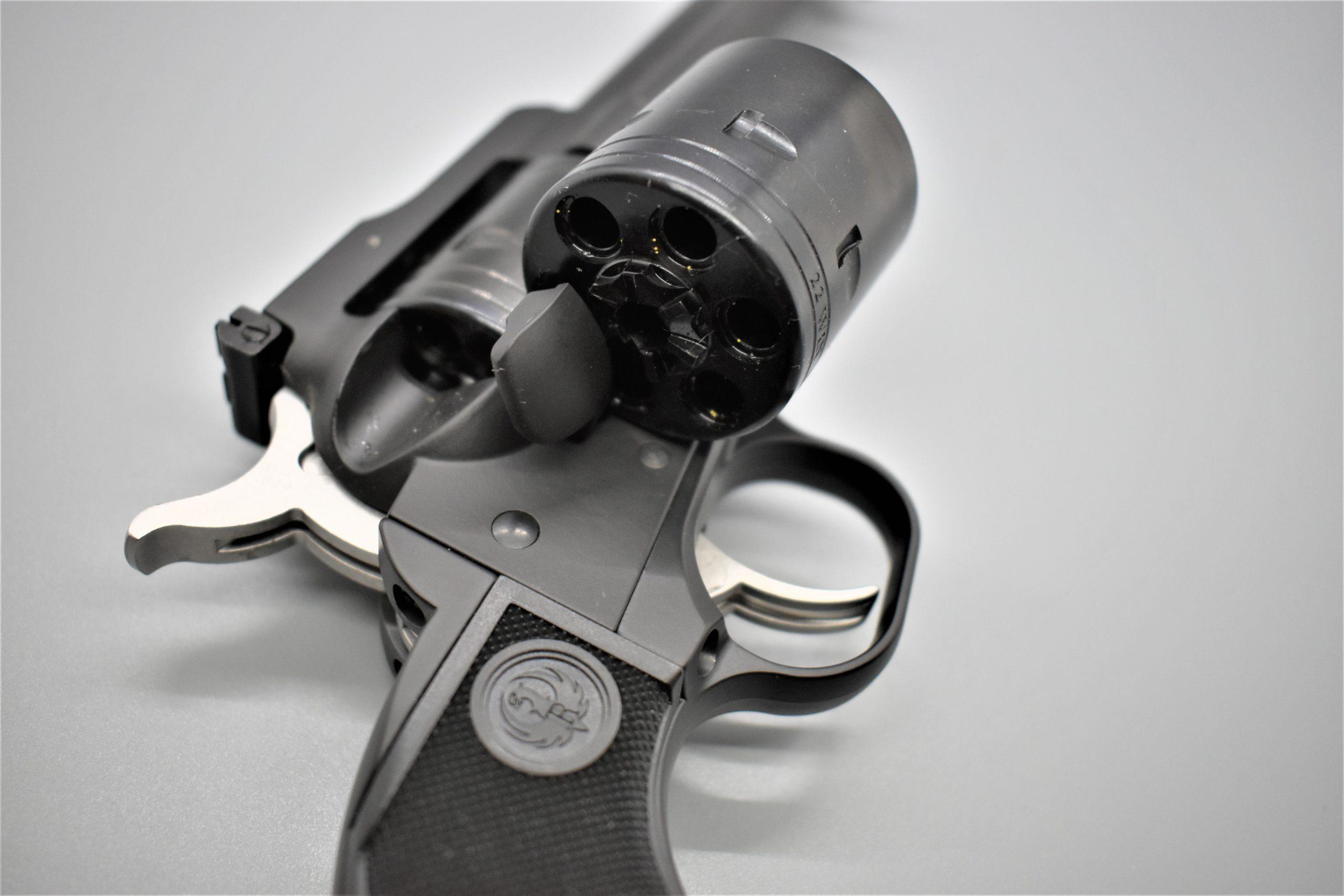
Specifications:
- Barrel Length: 5.5″
- Overall Length: ~11″ (approximately)
- Weight: ~35 oz (unloaded, approximately 5 oz heavier than standard due to steel frame)
- Sight Radius: ~6.5″ (estimated)
- Frame Material: Steel (not aluminum)
- Finish Options: Black Cerakote, Silver Cerakote, Burnt Bronze Cerakote
- Grips: Black checkered synthetic (traditional plow-handle style)
- Cylinders: TWO cylinders included – .22 LR and .22 WMR, 6 rounds each
- Sights: Adjustable rear sight, ramped post front
- MSRP: $329
- Street Price: $270-$300
Why Choose the Super Wrangler:
This is the variant that transforms the Wrangler from a budget plinker into a legitimate small game hunting and versatile rimfire platform. The two most significant upgrades—convertible cylinders and adjustable sights—address the biggest limitations of the standard Wrangler.
The included .22 WMR cylinder dramatically expands capability. While .22 LR is perfect for plinking and pests, .22 WMR delivers approximately 2-3 times the energy, making it far more effective on small game like squirrels, rabbits, and even predators like coyotes at close range. You’re essentially getting two guns in one.
The adjustable rear sight is equally important. With the standard Wrangler’s fixed sights, you’re stuck with whatever point of impact the gun delivers with your chosen ammunition. The Super Wrangler lets you dial in zero for different loads, which is critical when switching between .22 LR and the flatter-shooting .22 WMR.
The steel frame (versus aluminum on standard models) adds durability and about 5 ounces of weight. This extra heft helps manage the increased recoil of .22 WMR and provides a more solid shooting platform. The weight increase is noticeable but not problematic for most users.
Optimal Use Cases:
- Primary: Small game hunting (squirrels, rabbits) where .22 WMR provides needed power
- Secondary: Versatile plinking platform—practice with cheap .22 LR, hunt with .22 WMR
- Tertiary: Predator control (coyotes, foxes) at close range with .22 WMR
- Precision shooting: Adjustable sights allow serious accuracy work
Pros vs. Other Variants:
- Two calibers in one gun (.22 LR and .22 WMR)
- Adjustable rear sight allows precision zeroing
- Steel frame more durable than aluminum
- Significantly more capability for hunting with .22 WMR
- Still half the price of a comparable Single Six
- Longer 5.5″ barrel provides good velocity without being unwieldy
Cons vs. Other Variants:
- $60-70 more expensive than standard Wrangler
- Approximately 5 oz heavier (35 oz vs 30 oz)
- Still not as refined as a $600+ Single Six
- Fixed front sight (rear is adjustable only)
- Cylinder swaps require removing base pin (not instant like some designs)
Super Wrangler vs. Single Six Comparison:
This is where the Super Wrangler gets really interesting. A Ruger Single Six Convertible typically runs $550-$650, while the Super Wrangler retails for $329. That’s a $220-$320 difference for what are fundamentally similar capabilities: convertible cylinders and adjustable sights.
The Single Six gives you a finer build (better fit and finish, typically blued or stainless rather than Cerakote), more refined sights, and the prestige of the Single Six name. But the Super Wrangler gets you 80% of the performance for 50% of the cost. For most shooters who want a versatile rimfire revolver but don’t need absolute top-tier refinement, the Super Wrangler is the smarter buy.
Bottom Line: If you can afford the extra $60-70 over the standard Wrangler, this is the variant I’d recommend for most serious shooters. The convertible cylinders and adjustable sights transform it from a fun plinker into a legitimate hunting tool, and at $329, it’s still an exceptional value. This is the Wrangler that most directly competes with the Single Six in capability while maintaining budget-friendly pricing.
| Specification | Standard | Birdshead | Cavalry | Super Wrangler |
|---|---|---|---|---|
Barrel Length | 4.62" | 3.75" | 7.5" | 5.5" |
Overall Length | 10.25" | 8.62" | ~13" | ~11" |
Weight (unloaded) | 30 oz | ~27 oz | ~32 oz | ~35 oz |
Sight Radius | ~5.5" | ~4.5" | ~7.5" | ~6.5" |
Frame Material | Aluminum | Aluminum | Aluminum | Steel |
Sights | Fixed/Fixed | Fixed/Fixed | Fixed/Fixed | Ramp/Adjustable |
Grip Style | Plow-handle | Birdshead | Plow-handle | Plow-handle |
Cylinders Included | .22 LR only | .22 LR only | .22 LR only | .22 LR + .22 WMR |
Finish Options | 3 Cerakote colors | 3 Cerakote colors | 3 Cerakote colors | 3 Cerakote colors |
MSRP | $269 | $279 | $269 | $329 |
Typical Street Price | $160-$180 | $180-$200 | $170-$190 | $270-$300 |
Best For | General plinking all-around use | Compact carry trail gun | Accuracy small game hunting | Hunting versatile rimfire platform |
Specifications
Caliber: | .22LR |
Capacity: | 6 |
Action: | Single-Action |
Trigger Pull Weight: | 6.7 lbs |
Length: | 10.25” (or 8.62”) |
Barrel Length: | 4.62” (or 3.75”) |
Weight: | Weight: 30 oz. |
Sights: | Steel / fixed blade / rear notch |
Safeties: | Transfer bar & loading gate interlock |
MSRP: | $269-$279 |
Real-World Price: | $160-$180 |
Features

Single Action Simplicity
Great for new shooters and anyone who loves the SAA feel
Classic Looks
Screams “Wyatt Earp” from the grip to the barrel
Multiple Safeties
Pairing a transfer bar safety with a loading gate interlock doubles up on the safeties
Nothing You Don't Need
Does what you’d expect over and over at an affordable price point
First, let’s start with the basics, then we’ll go into more detail later on.
Ultimately, the Wrangler operates very similarly to pretty much any other single-action revolver. The cylinder rotates on a removable base pin. It doesn’t swing out and is instead loaded by opening the loading gate and placing rounds into the empty chambers one at a time.

Once you’ve finished shooting, you can remove the empty cartridges one by one with the spring-loaded ejection rod.
As for other internal mechanisms, the Wrangler has great safety features like a transfer bar safety and a loading gate interlock.
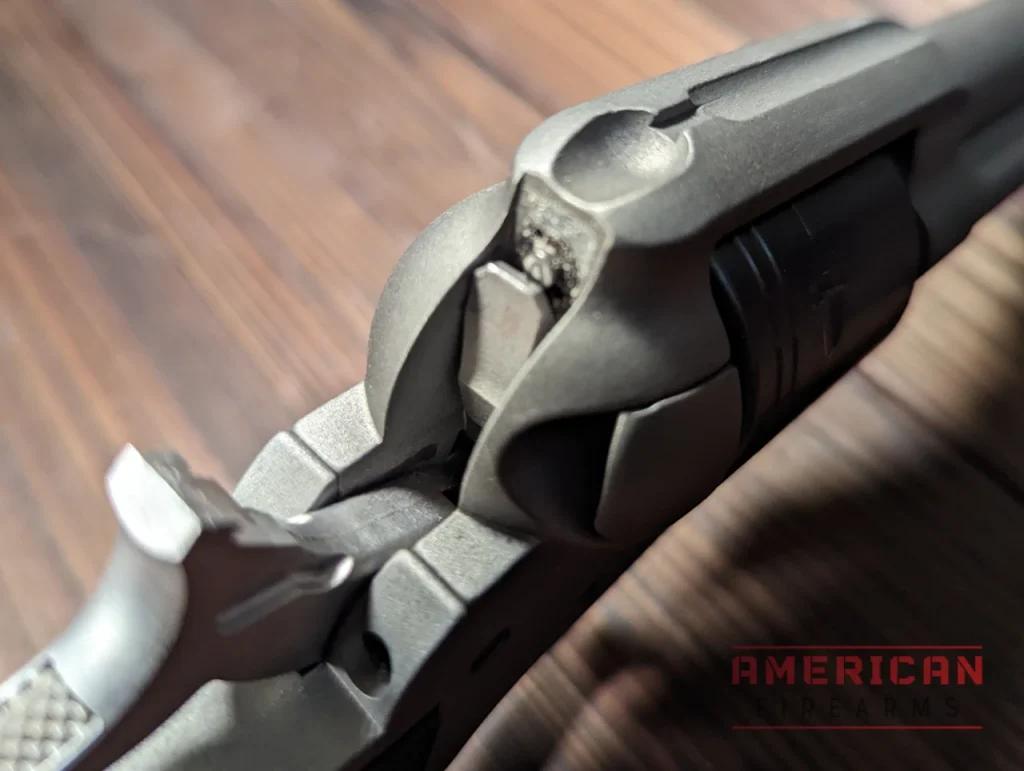
The former means that unless the trigger is depressed, the hammer cannot strike the firing pin.
The latter means that opening the loading gate, which allows the cylinder to spin freely, is impossible unless the hammer is down. Note that this is an alternative to the half cock position you find on other revolvers, so the Wrangler’s hammer has to be forward for loading.
For durability, this .22LR revolver has an aluminum alloy frame with a Cerakote finish for corrosion protection. The synthetic grips are always black, but the Cerakote finish comes in Black, Silver, and Burnt Bronze.
It also has a cold hammer-forged barrel (4.62” on the full-length version and 3.75” on the shorter version) and fixed sights.
Primarily, I think the Ruger Wrangler is an ideal fun gun. Its easy operation, reliability, and light recoil make it a delight to shoot, and mine is one of my favorite plinking guns.

Those same features also make it great for new shooters, since learning how to use and maintain the Wrangler is incredibly easy.
It could also be used for competitive shooting if you’re just getting started and want an affordable, entry-level revolver. However, it’s probably worth shelling out for a higher-end revolver if you can afford it, especially as you get more serious.
Straightforward Sights

The sights are one of the biggest differences between the Ruger Wrangler and the Single Six, so let’s knock them out early.
The Wrangler has a fixed blade front sight and a fixed rear notch sight. The fixed sights are one way that Ruger keeps the price down on the Wrangler compared to the Single Six, but they’re still SAA style and provide a good sight picture.
While having the adjustable rear sight would be nice, the sights are very durable and still perform well, so I’ll take it if it helps keep the revolver at a lower price point. The sights are what I’d call “serviceable” for most uses, but also perfectly executed at this price point.
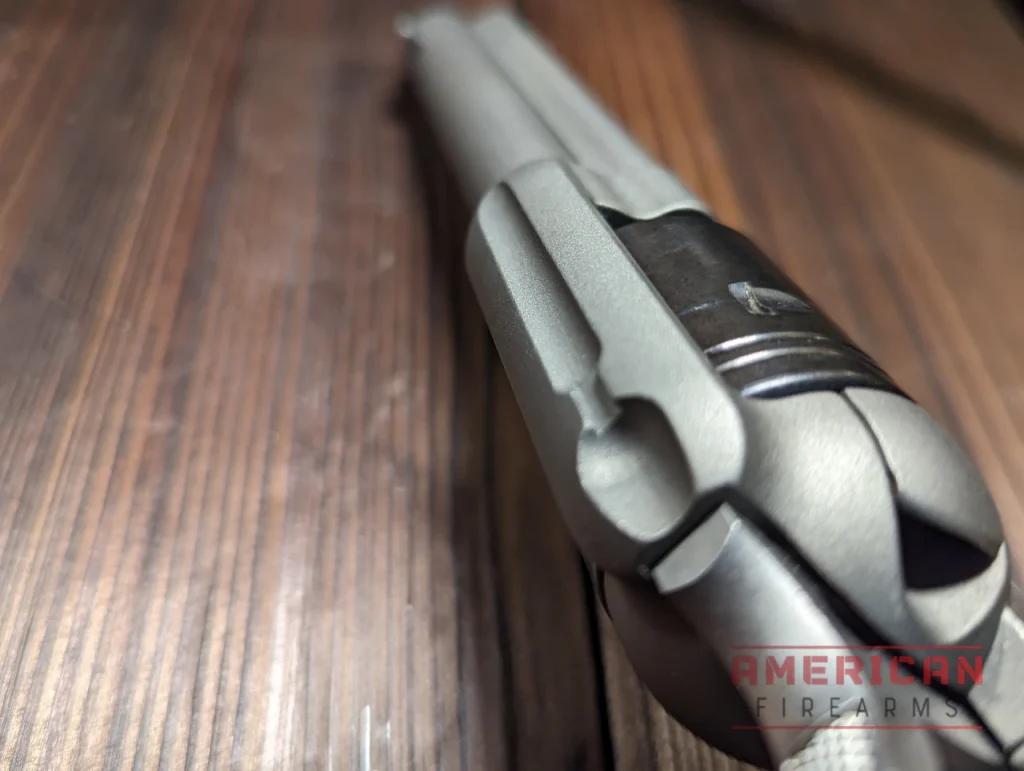
Quality Control
I’ve always been impressed with Ruger’s quality control and never had a problem myself, including with my Wrangler, so there’s really not much to critique here.
I will say that from talking to other gun writers, when the occasional QC issue does happen, Ruger handles them well. If you do find a QC issue on your Wrangler (or any other Ruger for that matter), Ruger makes it easy to send the gun in and get it fixed. The turnaround time is usually just a couple of weeks and your gun should come back in perfect condition.
The Wrangler, in particular, really feels like a well-engineered product. There’s an old saying that “Anyone can build a bridge that stands, but it takes an engineer to build one for as cheap as possible”. That’s what the Wrangler feels like. It feels distilled down into just what you need in a budget revolver, with all the fat stripped away.
The materials aren’t super high-end, but the fit and finish are excellent, especially for the price.
Comfort and Control

The shape of the Wrangler’s grip is clearly inspired by the SAA grip and, in fact, is the same grip used on Ruger’s New Model Single Six. I have small hands, so the Wrangler has plenty of space for me, but shooters with larger hands feel a bit cramped. It’s also not as ergonomic as you might be used to if you’ve primarily handled semi-autos, but it’s not bad, especially once you get used to it.
The checkered synthetic grips aren’t as good-looking as the classic wooden or pearl grips that you often see on SAAs and some other single-action revolvers, but they do help enhance the revolver’s ergonomics, especially with the diamond texturing on them.
Still, they’re not exactly something to write home about. There are certainly better grips out there, but there are also far worse.
In addition, the alternate version uses a different grip style, Ruger’s Birdshead pattern grip frame with synthetic grip panels.
In your hand, the Wrangler feels pretty balanced, though a bit barrel-heavy. It’s overall very lightweight though.
A Smooth, If Heavy Pull
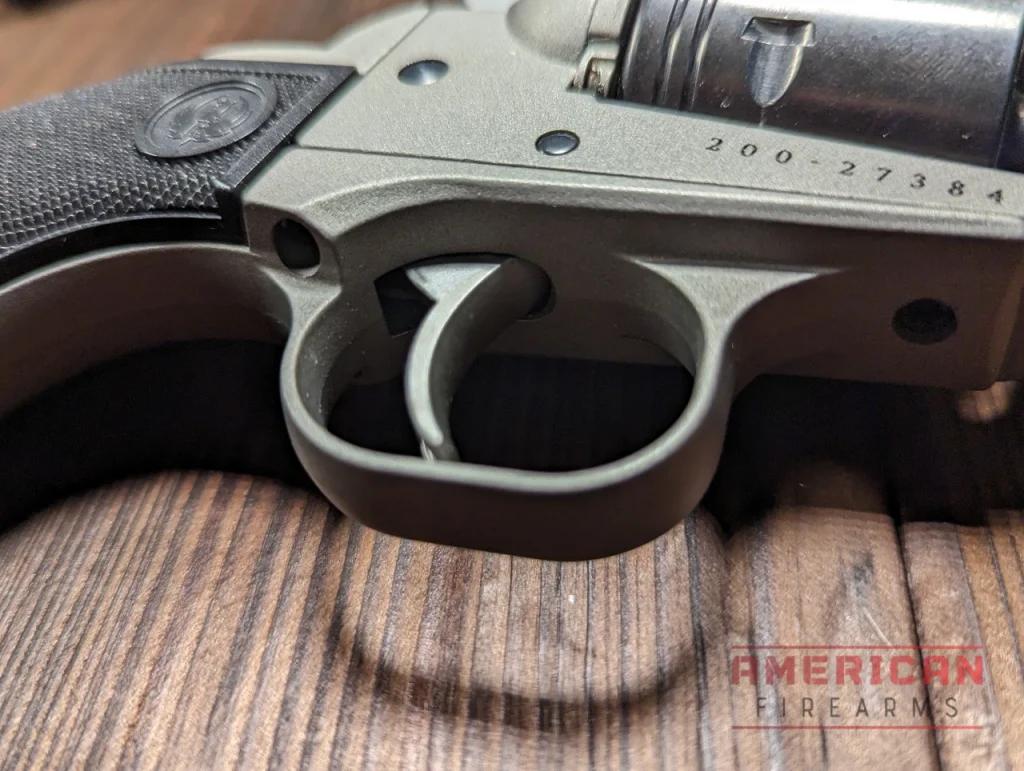
The trigger on the Wrangler is surprisingly good for the price, but it’s a single-action revolver so it’s a bit hard to mess up. It’s more than sufficient for the kind of light pest control and target shooting this revolver is most likely going to be used for.
With a trigger weight of 6.8 pounds, it’s a bit heavier than I’d prefer (and even heavier than my husband, who typically likes a heavier trigger would prefer as well). There’s also more creep than I’d like, but it’s not bad for a trigger on a gun at this price point.
Consistently Dependable Performance
Rugers are known for reliability, as are revolvers, and the Wrangler is no exception.
As for accuracy, the Wrangler does the job for plinking, but I’d probably skip over it for hunting though, in favor of the more accurate Single Six.
Within about 10 yards, my groups tend to stay within about two inches. Of course, that depends on ammo. With CCI Stinger and some other rounds, those groups get bigger. On the other hand, with SK Match, I can get groups as close as around 1.3 inches.
After about the 10-yard mark, those groups do loosen up, as one would expect.
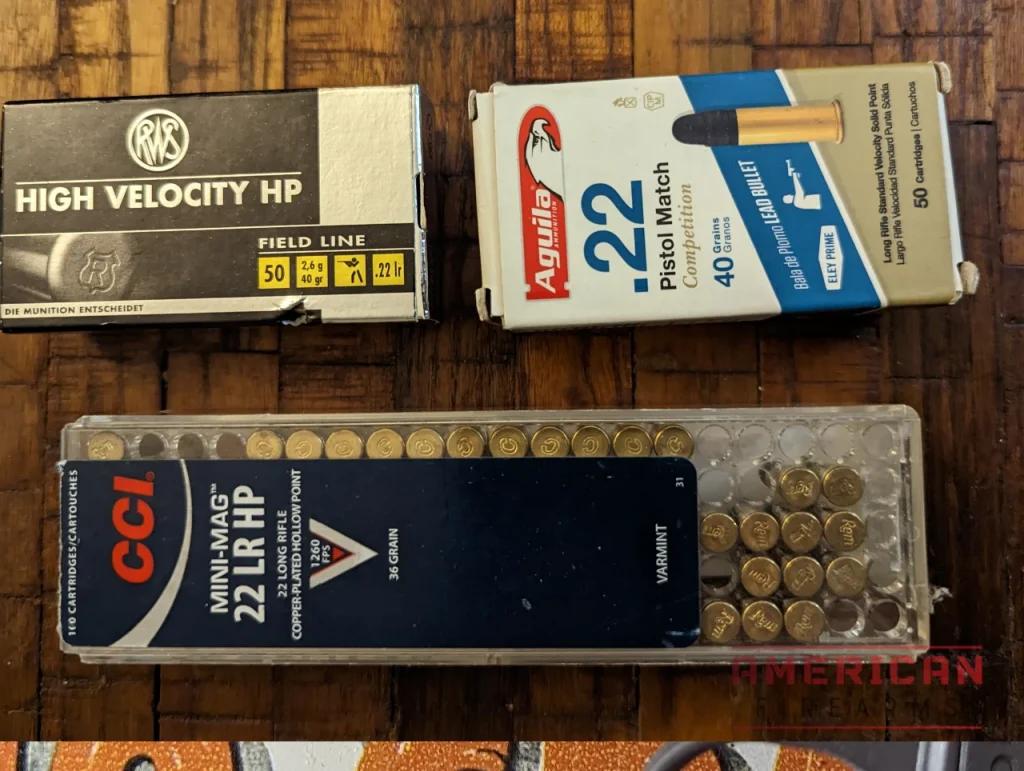
Range Report
| Ammunition | Vel. (fps) | E.S. (fps) | S.D. (fps) | 25-Yd. Acc. (in.) |
|---|---|---|---|---|
.22 LR 4.62-in. Barrel | ||||
CCI Stinger 32-gr. CPHP | 1368 | 47 | 22 | 2.75 |
Remington Thunderbolt 40-gr. LRN | 1095 | 52 | 24 | 3.50 |
CCI Mini-Mag 36-gr. CPHP | 1247 | 38 | 18 | 2.25 |
Federal Champion 40-gr. LRN | 1112 | 44 | 21 | 3.25 |
CCI Blazer 40-gr. LRN | 1126 | 49 | 23 | 3.00 |
Aguila Super Extra 40-gr. CPRN | 1138 | 41 | 19 | 2.75 |
NOTES: Accuracy is the average of three, six-shot groups fired from a sandbag benchrest at 25 yards. Velocity is the average of 10 rounds measured 12 feet from the gun’s muzzle. Testing conducted with Standard 4.62″ barrel model. Extreme Spread (E.S.) and Standard Deviation (S.D.) reflect typical rimfire ammunition variance.
To start, the Wranger comes from the factory with a pretty stiff loading gate. Mine wore in pretty quickly, though, so it’s not something to stress about. It’s still pretty stiff, but it’s certainly manageable.
But let’s be real: what you really want to know about is how it shoots.
To find out, I took my Wrangler to the range and put it through its paces. I shot just under 300 rounds of various ammo through it and had some friends also give it a workout to the tune of another 250+ rounds.
Overall, we were all extremely impressed. Two of the folks I went with actually liked mine so much that they ordered their own (in black and bronze Cerakote) while we were at the range. These are experienced gun folk, including a fellow gun writer like myself, so that’s high praise in and of itself.
As far as my own experience with it, I found it to be a very pleasant experience. I didn’t experience any issues, other than one which I’ll go over in a minute, and I found the trigger and basic sights to be accurate enough.
We shot a variety of nicer ammo as you can see below, but the bulk of what we shot was simple Remington Thunderbolt (green box) 40gr all-lead cheap stuff. That feels like what this revolver is going to be fed most of the time. It’s not going to ever be a bullseye pistol with those sights and that trigger.
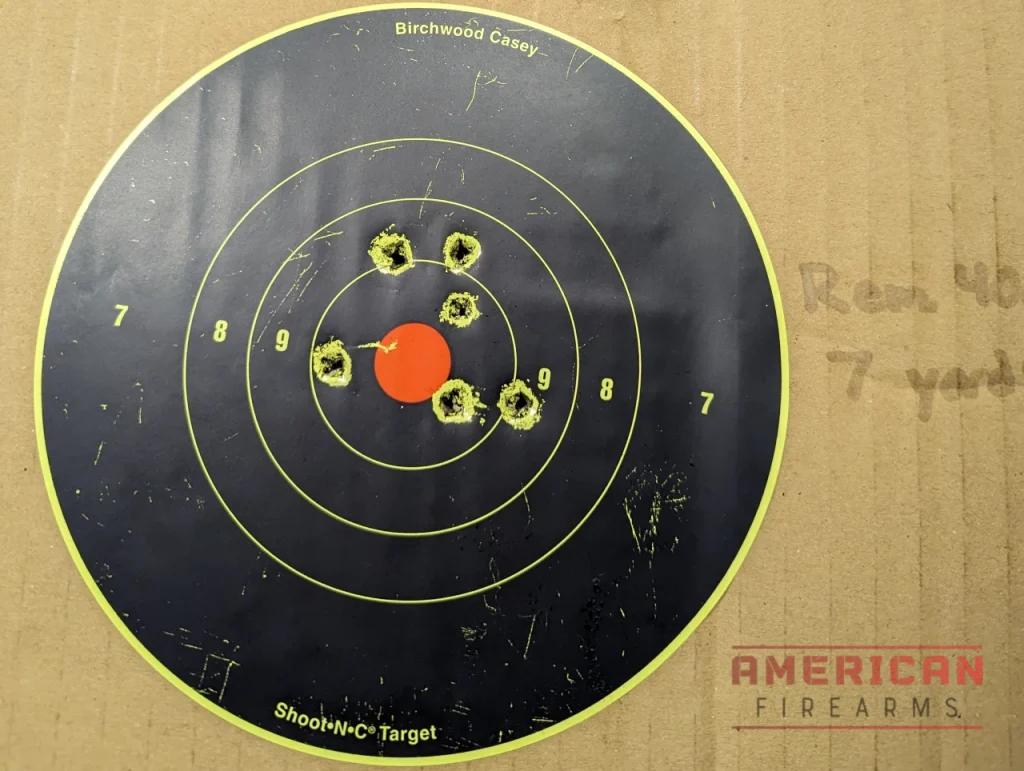
Here you can see how this ammo faired at 7 and 15 yards. Honestly, not bad at all for real-world use and something I’d be happy to rely on for dispatching small pests or even game animals. Is the revolver capable of better out of a rest? Sure.

Is anyone ever going to shoot it off a rest? Absolutely not. This is a real-world result, and one I’m quite pleased with.
We did experience a few issues that you could probably classify as user error. The cylinder didn’t quite index properly one time when we decided to be silly and fan the hammer, cowboy-action style, but that was more our own inexperience with doing that type of thing.
It did feel like a real test because this revolver, while a gun that should be treated with respect like all guns should…kinda feels like something to just have fun with. I think we, as gun owners, can sometimes get too caught up in stats on paper, or “tactical” considerations and forget that this is a hobby that many of us participate in because it’s just plain fun.
This gun, the Ruger Wrangler, is fun. It’s cheap, easy to shoot, and reasonably accurate. And that translates to a good time at the range, or on the back-40 blasting cans off a berm.
Takedown & Maintenance
Though it doesn’t swing freely, the cylinder itself can be removed. To do so, simply press down the base pin latch, then slide the base pin forward. Now swing the loading gate open and the cylinder will pop right out.
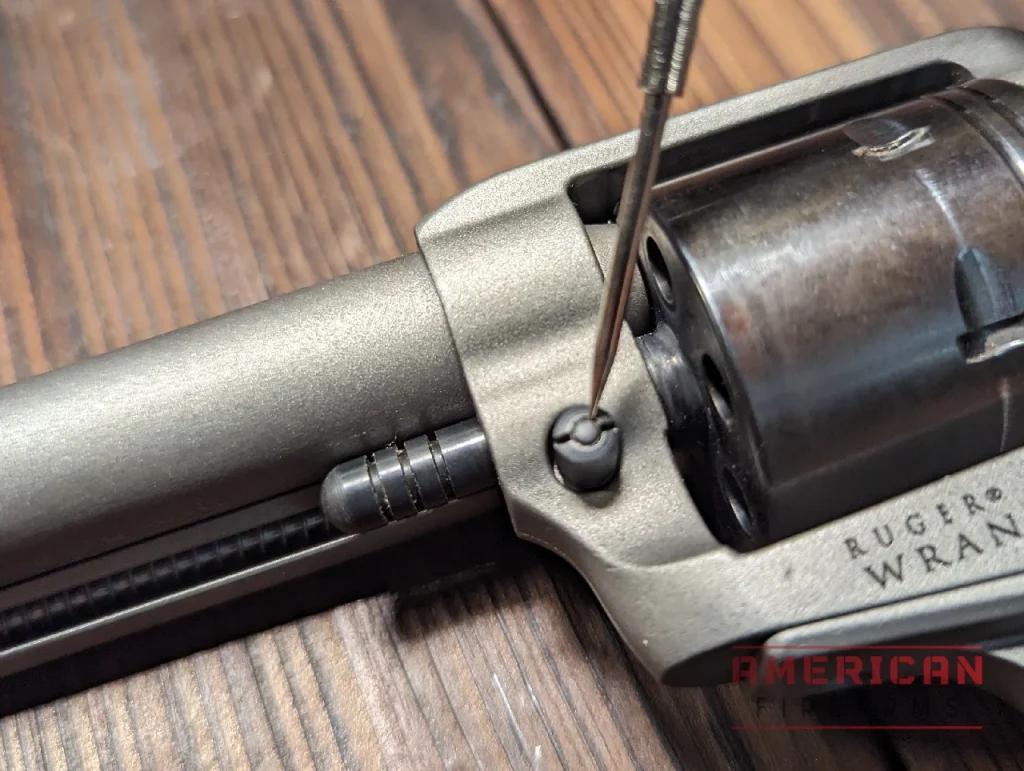
You can see the button above, and the disassembled revolver below. Very straightforward, and familiar to most single-action revolver owners I would imagine.
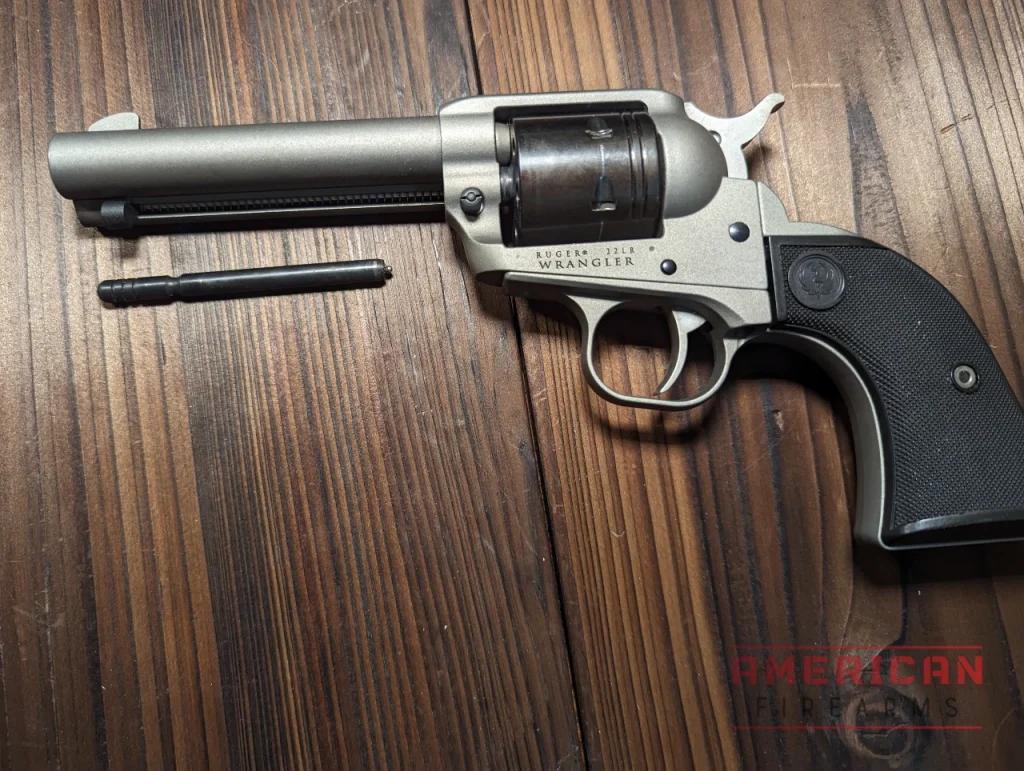

Though the revolver can be disassembled more, that’s all you really need to do for standard cleaning and maintenance. If you’re not sure how to do more, you’re probably best off bringing it to a gunsmith for service.
One other thing you can do is easily remove the grips and get access to the mainspring and everything else inside the grip. The main reason you would probably want to do this would be to swap the grips, which are compatible with Single Six grips, so you have myriad options to choose from.
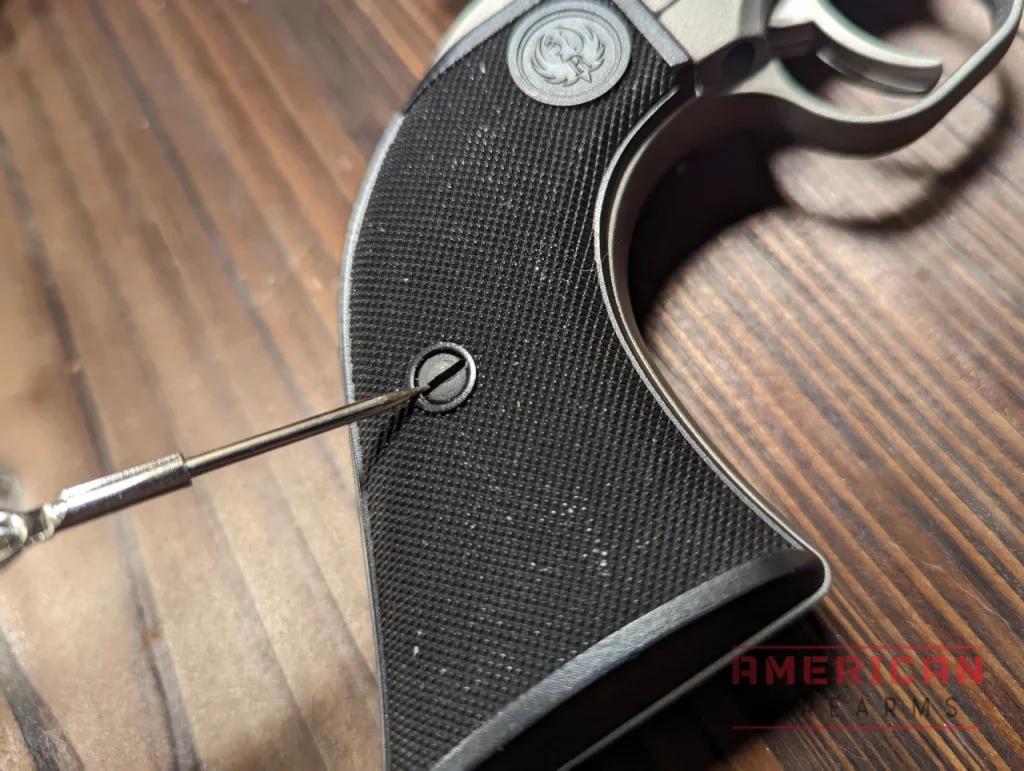
Incidentally, one of the things that truly bugs me about this revolver is the fact that in the black grip, where the black screw threads into the grip is an unpainted metal insert that remains bright silver.
Come on Ruger, it sticks out like a sore thumb and cheapens an otherwise solid build. You guys could have used a coated part for that. Other than that though, I love being able to swap the grips out quickly and easily, and being able to get to the mainspring if needed.
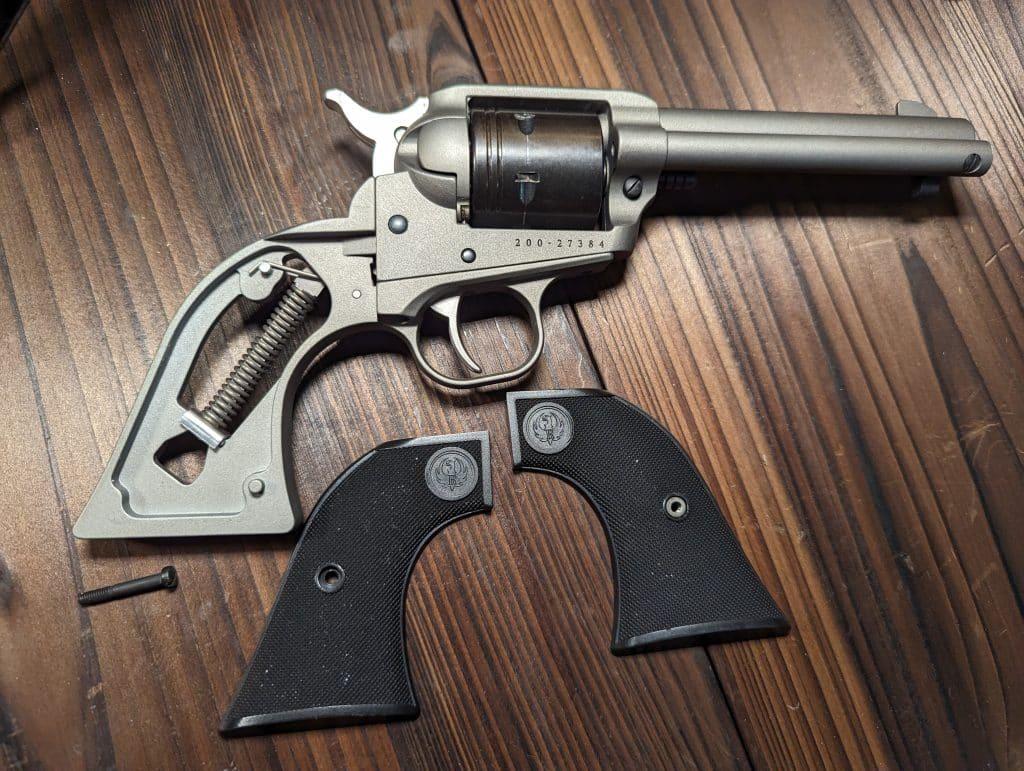
Shortcomings
The overall quality of the Ruger Wrangler is excellent, but it’s not perfect and there are definitely a few things I wish were better.
The so-so trigger is probably the most notable, with its heavy-ish pull and tendency towards creep.
Interchangeable cylinders to allow the option to shoot with .22 Magnum, like you see in some other revolvers in this class, would have been nice.
The Wrangler’s sights are pretty good, but it would have been nice to have an adjustable rear sight. Similarly, the factory grips are alright, but fortunately, you can upgrade them relatively easily.
Finally, I also would have liked to have a higher capacity, especially since loading is a bit of a hassle. Six rounds is traditional though, I suppose.
However, none of these shortcomings are a huge deal, and they aren’t unsurprising for a revolver at the Wrangler’s price point. Realistically, if Ruger had designed the Wrangler without them, it would be a far costlier gun, and the low cost is a major selling point for the Wrangler.
If you’re going to get a revolver for less than $300, you have to accept some flaws, and the flaws the Wrangler has are far from deal breakers.
Alternatives
Now that we know all about the Ruger Wrangler, let’s compare it to some other guns in the single-action revolver family to help you figure out if it’s the best gun for you.
Heritage Rough Rider
As another budget-friendly single-action revolver, the Rough Rider is the Wrangler’s main competitor. Overall, the two revolvers are pretty similar. They’re about the same size, both are based on the SAA design, both have a six-shot capacity, both have an aluminum alloy frame, and both feature bladed front sights that offer a decent sight picture.
However, I think Ruger does a better job with manufacturing. The Wrangler feels like an overall better-made revolver, but many people who’ve bought Rough Riders report visible machine marks, especially on the cylinders.
Maybe that’s not surprising, since the Rough Rider retails for less, but the prices are close enough that I think it’s worth it to shell out the extra $50 or so bucks for the Wrangler.
One thing that the Rough Rider does have over the Wrangler is options. The Rough Rider is available in a massive number of different grip styles and several different barrel lengths, while the Wrangler is more limited.
The Rough Rider also provides the ability to swap out the cylinder, allowing you to use the same revolver to also shoot .22WMR.
Ruger Single Six
As promised, let’s talk about the Ruger single-action revolver from which the Wrangler gets its basic design.
If the Wrangler is a Toyota, the Single Six is a Lexus: manufactured by the same company and overall very similar, but with enough upgrades to make you consider shelling out the extra cash if you can. In fact, the Wrangler was announced as, essentially, a budget Single Six.
One major advantage of the Single Six is also one that the Rough Rider has: interchangeable cylinders. Like the Rough Rider, the Single Six allows you to swap out the cylinder to once chambered for .22 WMR, so you can shoot either caliber out of the same revolver.
It also has more options than the Wrangler, including both barrel length and grip material.
For other upgrades, the Single Six swaps out aluminum alloy in the Wrangler frame for alloy steel, making the gun weightier but also more durable. In addition, unlike the Wrangler’s fixed sights, the Single Six has an adjustable rear sight.
Of course, all of that comes at about $500 more than the Wrangler. For me, it wasn’t worth it, but if I wanted a competition revolver rather than a fun gun (or just had an unlimited budget for gun buying), it would be much easier to justify.
Upgrades
If you’re looking for an upgradable gun, revolvers in general aren’t your jam. The Wrangler is especially lacking in this department, unfortunately.
The main thing you can upgrade is the grip panels, which is fortunate since the factory grips are only mediocre. And since they’re the same as the grip panels on the New Model Single Six, you do actually have a good number of options.
Premium Gun Grips is a great option, especially if you’re looking to replace the synthetic grips with a more classic-looking wooden option. They have plenty of other options too, though. My favorites are the faux pearl. They even have a few options for the Birdshead version.
Otherwise, there’s really not much out there. The Wrangler has only been out for a few years though, so hopefully, we’ll see that change in the future.
The Shooter's Score
How does Ruger’s little rimfire revolver stack up?
Accuracy: 7
The Wrangler provides fair accuracy for plinking and everyday use, but this is no precision pistol. It’s basic sights and heavy trigger hold it back here.
Ergonomics: 6
The old school grip may feel cramped for shooters with larger hands, and it lacks the ergonomic design of semi-autos, but it’s still manageable and comfortable enough for most.
Fit and Finish: 8
Ruger makes good stuff, and the Wrangler offers up excellent fit and finish for its price. Solid engineering and quality control ensure you’ll take home a well-made revolver.
Features: 5
While the Wrangler lacks features like an adjustable rear sight and interchangeable cylinders, you’re getting the basics anyone would expect from a budget revolver, which isn’t much.
Reliability: 9
Ruger’s reputation for reliability holds true with the Wrangler. It does the job without any issues, making it both a fun and dependable choice for plinking.
Value: 9
Weighing its affordable price, solid build quality, and overall performance, the Wrangler is an awesome value that gives you serious fun with a not-so-serious price point.
Pros and Cons
Pros
- Fun, fun, fun
- Surprisingly well-built
- Multiple safety systems
- Recoil is AWOL
- Aluminum frame keeps it light
Cons
- Shockingly heavy trigger pull
- 6-rounds is not a lot of pew
- Non-adjustable rear sight
- Small, non-ergonomic grip
- Non-interchangeable cylinder
Wrap Up
All in all, the Ruger Wrangler surprised me…but maybe it shouldn’t have. Ruger has been turning out reliable, high-quality, but still budget-friendly guns pretty regularly for years now.
I’m hard-pressed to think of a major miss they’ve had in that market segment, and the Wrangler certainly seems like a hit (especially when you look at sales numbers).
It’s a solidly built little .22 LR handgun that does what you’d expect, at an affordable price that’s going to be palatable to any shooter. It’s not likely to be an heirloom piece, carry pistol, or a bullseye champion, but it’s as dependable as you could ask for it to be.
Ruger has built their brand on sensible, value-minded products lately and the Wrangler is a worthy addition to that brand.
FAQs
Is the Ruger Wrangler reliable?
Which is better Ruger Wrangler vs Heritage Rough Rider?
Can you rapid-fire Ruger Wrangler?
Can you convert the Ruger Wrangler to .22 Magnum?
What is the difference between Ruger Wrangler and Super Wrangler?
What grips fit the Ruger Wrangler?
How do you clean a Ruger Wrangler?
Can you dry fire the Ruger Wrangler?
What holsters fit the Ruger Wrangler?
Is the Ruger Wrangler made in the USA?
Updated
December 27th, 2025 – Added comprehensive variant breakdown covering all four Wrangler models including 2024 Super Wrangler, expanded FAQ coverage, and detailed “How We Test” methodology explaining our 500+ round testing process.
Sign up for our newsletter
Get discounts from top brands and our latest reviews!




